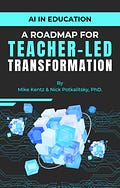I’m proud to share that my book with
is now live on Amazon. “AI in Education: A Roadmap for Teacher-Led Transformation” provides actionable strategies for kickstarting proactivity in yourself and your community around AI and its impact on education.Vera Cubero, Emerging Technologies Consultant at the North Carolina Department of Public Instruction and one of the lead authors of the state’s AI guidelines, had this to say about the book:
"AI in Education: A Roadmap for Teacher-Led Transformation" delivers fresh, forward-thinking strategies for school leaders navigating AI integration. It emphasizes the critical role of educators over technology, advocating for teacher-led innovation and AI literacy to drive meaningful change.”
Cubero is also an EDSAFE Alliance Catalyst Fellow and member of the Southern Regional Education Board’s Commission on Artificial Intelligence. She added:
“With practical steps for ethical AI use and a people-first approach, it empowers leaders to thoughtfully transform their schools for the intelligence age. A must-read for any educator aiming to thoughtfully transform their school’s approach to AI."
Table of Contents:
Introduction
Chapter 1: Adapting to AI through The Five Stages of Grief
Chapter 2: AI's Impact on Existing Educational Challenges
Chapter 3: From Tech-Driven to Teacher-Led Transformation
Chapter 4: Developing AI Literacy Among Faculty: A Comprehensive Guide
Chapter 5: Designing an AI-Responsive Writing Curriculum Focused on Voice
Chapter 6: Transforming Challenges into Opportunities: A Process-Based Assessment Approach for the Age of AI
Conclusion
It’s only $14.99! Pick up your copy now!
The Substack community has been a supportive and generous space for me since I launched this blog in April of this year. I have been amazed at the level of kindness and thoughtful decency in the comments, discussions, and connections that I have seen on my blog and across the network. Without you, this book would not be a reality.
Thanks, as always, for your support!
Mike




Ottimo lavoro, vi seguo. Quando una traduzione in italiano?